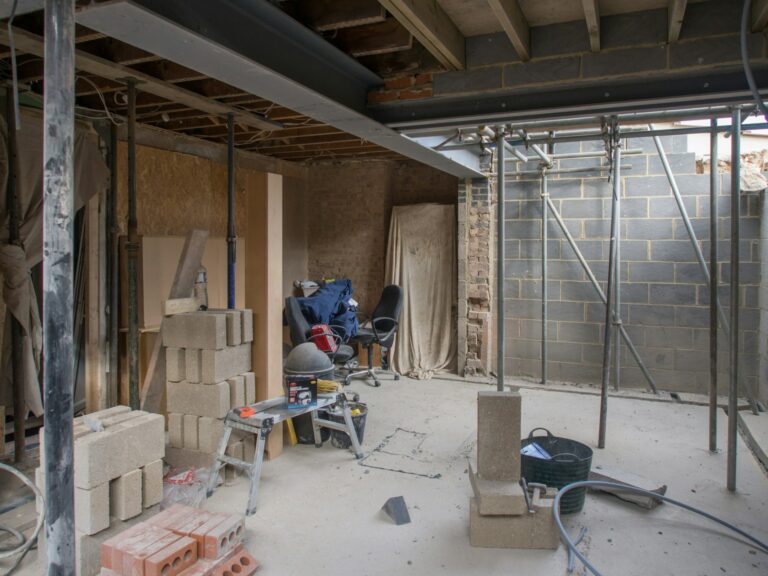The kitchen serves as the heart of most homes, making it one of the most important spaces to get right when planning renovations.
Current design trends reflect a shift toward functionality, sustainability, and personal expression that goes beyond fleeting style movements. Understanding these trends can help you make informed decisions that enhance both your daily life and your home’s value.
Modern homeowners are moving away from cookie-cutter designs toward spaces that reflect their unique needs and preferences. This evolution in kitchen design emphasizes smart storage solutions, eco-friendly materials, and technology integration that makes daily tasks easier and more enjoyable.
Smart Storage Solutions Transform Kitchen Functionality
Multi-Level Organization Systems
Contemporary kitchen remodel projects increasingly feature sophisticated storage systems that maximize every inch of available space.
Pull-out drawers in lower cabinets, lazy Susans in corner spaces, and vertical dividers for baking sheets and cutting boards create organized, accessible storage that reduces clutter and improves workflow. Cabinet manufacturers now offer modular systems that can be customized to fit specific needs.
These systems include specialized inserts for spices, utensils, and small appliances, ensuring everything has a designated place. The result is a cleaner, more efficient kitchen that functions better for daily meal preparation.
Hidden Storage Integration
Modern design trends favor clean lines and uncluttered surfaces, driving demand for hidden storage solutions.
Appliance garages conceal small appliances like coffee makers and blenders, while toe-kick drawers utilize previously wasted space beneath cabinets for storing flat items like baking sheets and cutting boards.
Island storage has evolved beyond simple cabinets to include built-in wine coolers, charging stations for devices, and even pet feeding stations. These integrated solutions maintain the kitchen’s aesthetic appeal while adding practical functionality.
Sustainable Materials Lead Design Choices
Eco-Friendly Cabinet Materials
Environmental consciousness drives many current design trends, with homeowners seeking sustainable options that don’t compromise on style or durability. Bamboo cabinets offer a renewable alternative to traditional wood, while reclaimed wood brings character and history to modern kitchens.
Low-VOC (volatile organic compound) finishes improve indoor air quality while protecting cabinet surfaces. These finishes come in a wide range of colors and textures, allowing homeowners to achieve their desired aesthetic while maintaining environmental responsibility.
Recycled and Upcycled Elements
Creative reuse of materials adds unique character to kitchen spaces. Recycled glass countertops incorporate post-consumer materials while offering beautiful, durable surfaces. Reclaimed brick or stone can create stunning backsplashes that tell a story while reducing environmental impact.
Some homeowners choose to refinish existing cabinets rather than replace them entirely, updating hardware and paint colors to achieve a fresh look at a fraction of the cost and environmental impact of a complete replacement.
Technology Integration Enhances Daily Life
Smart Appliance Coordination
Connected appliances work together to streamline meal preparation and kitchen management. Smart refrigerators can track inventory and suggest recipes based on available ingredients, while connected ovens can be preheated remotely and provide cooking notifications to smartphones.
Voice-activated assistants integrate with kitchen systems to control lighting, play music, set timers, and answer cooking questions hands-free. This technology proves especially valuable when hands are busy with food preparation.
Charging and Communication Hubs
Modern kitchens serve as family communication centers, requiring thoughtful integration of charging stations and device storage. Built-in USB outlets eliminate countertop clutter while ensuring devices stay charged and accessible.
Command centers with bulletin boards, calendars, and device docking stations help families stay organized while maintaining the kitchen’s aesthetic appeal. These solutions recognize that kitchens function as more than cooking spaces in contemporary homes.
Color and Texture Trends Create Visual Interest
Warm Earth Tones Replace Cool Grays
The previously dominant cool gray palette is giving way to warmer, more inviting color schemes. Sage green, warm beige, and soft terracotta create cozy, welcoming atmospheres that feel more personal and less sterile than stark white or gray kitchens.
These earth-inspired colors pair beautifully with natural materials like wood and stone, creating cohesive design schemes that feel grounded and timeless. The trend toward warmer colors reflects a desire for spaces that feel nurturing and comfortable.
Mixed Textures Add Depth
Successful modern kitchens combine multiple textures to create visual interest and prevent monotony. Smooth quartz countertops might pair with rough-hewn wood shelving, while sleek metal hardware contrasts with matte cabinet finishes.
Natural stone backsplashes, woven pendant light fixtures, and textured cabinet doors work together to create layers of visual and tactile interest. This approach prevents kitchens from feeling flat or one-dimensional.
Open Concept Layouts Evolve
Defined Zones Within Open Spaces
While open-concept layouts remain popular, current design trends favor creating distinct zones within larger spaces. Kitchen islands serve as natural boundaries between cooking and living areas, while changes in flooring materials or ceiling heights can subtly define different functional zones.
Bar seating at islands creates casual dining areas that encourage family interaction while maintaining a visual connection to adjacent living spaces. These transitional areas bridge the gap between formal and informal entertaining.
Flexible Furniture Solutions
Moveable elements add versatility to kitchen layouts. Rolling carts can provide extra prep space when needed and be tucked away when not in use. Stackable stools are stored neatly under islands but can be deployed for additional seating when entertaining.
This flexibility allows kitchens to adapt to different needs throughout the day, from quiet morning coffee preparation to lively evening entertaining.
Lighting Design Creates Ambiance
Layered Lighting Systems
Effective kitchen lighting combines task, ambient, and accent lighting to create functional, beautiful spaces. Under-cabinet LED strips illuminate work surfaces, while pendant lights over islands provide focused task lighting for food preparation.
Dimmer switches allow homeowners to adjust lighting levels throughout the day, creating bright, energizing environments for cooking and softer, more relaxing atmospheres for casual dining or entertaining.
Statement Light Fixtures
Bold pendant lights and chandeliers serve as focal points in modern kitchens, adding personality and style to functional spaces. These fixtures can introduce color, texture, or metallic accents that complement the overall design scheme.
Oversized fixtures make a particular impact in kitchens with high ceilings, while smaller spaces benefit from sleek, minimalist designs that provide necessary illumination without overwhelming the space.
Backsplash Designs Make Bold Statements
Geometric Patterns and Shapes
Traditional subway tile gives way to more adventurous backsplash designs featuring geometric patterns, hexagonal tiles, and three-dimensional surfaces. These designs add visual interest and personality to kitchen spaces while maintaining practical functionality.
Fish scale tiles, chevron patterns, and mixed tile sizes create dynamic backsplashes that serve as focal points. These designs work particularly well in otherwise neutral kitchens where the backsplash provides the primary source of visual interest.
Natural Stone and Marble
Luxurious natural stone backsplashes bring elegance and timeless appeal to kitchen spaces. Marble slabs create seamless, sophisticated looks, while natural stone tiles add texture and variation that complements other natural materials in the kitchen.
Book-matched stone creates stunning focal points behind ranges or sinks, while smaller stone tiles can be arranged in interesting patterns that add movement and visual flow to the space.
Appliance Trends Focus on Performance
Professional-Grade Features
Home cooks increasingly seek appliances with restaurant-quality performance capabilities. Induction cooktops provide precise temperature control and energy efficiency, while convection ovens offer even heating and faster cooking times.
Built-in coffee systems, steam ovens, and warming drawers cater to homeowners who enjoy entertaining and want to elevate their culinary capabilities. These appliances often feature sleek, integrated designs that maintain kitchen aesthetics.
Energy Efficiency Priorities
Energy-efficient appliances reduce utility costs while supporting environmental sustainability goals. Energy Star-rated refrigerators, dishwashers, and other appliances use less electricity and water without sacrificing performance.
Some homeowners choose to invest in high-efficiency appliances as part of full home remodeling projects, creating comprehensive energy-saving solutions that reduce long-term operating costs.
Planning Your Kitchen Transformation
Understanding current design trends helps inform your renovation decisions, but successful projects require careful planning and professional execution. Consider how each trend aligns with your lifestyle, budget, and long-term goals for your home.
Research local contractors who specialize in kitchen renovations and have experience with current design trends and technologies. The right professional can help you navigate options, avoid costly mistakes, and ensure your home upgrade delivers the results you envision.
Your kitchen should reflect your style while incorporating functional improvements that enhance daily life. By understanding current trends and working with qualified professionals, you can create a space that serves your family’s needs while adding value to your home.


